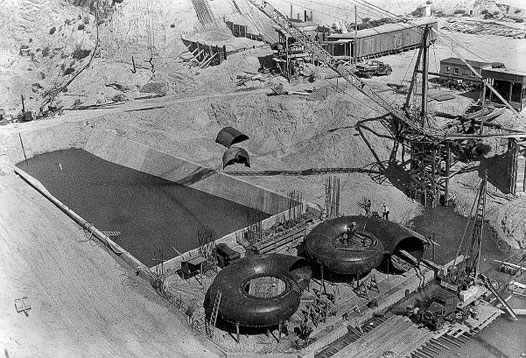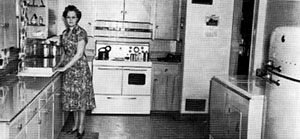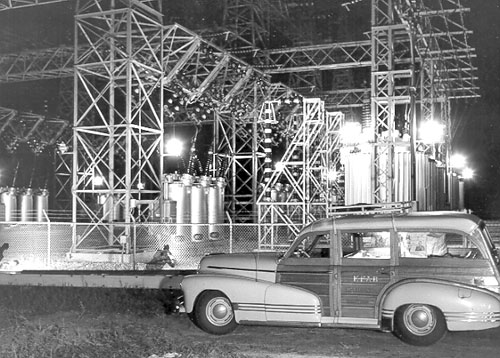Custer Public Power District was organized on September 19, 1944, but it was not until the Fall of 1945 that the installation of poles, power lines and other equipment necessary to bring electricity to the rural home was finally completed and the first customers received power. Today Custer Power supplies electric power over 4600 miles of distribution lines, and is geographically the largest rural public power district in Nebraska serving over 8000 square miles of territory.
Original Board of Directors 1944
 Frank Haumont President |
 Bryan Holmes Vice President |
 Ira Cool Sec./Treas |
 M. L. Gould |
 Clarence Rodine |
 Vance Smith |
 Roy Rhodes |
These directors were elected at the meeting attended by approximately 800 Custer County citizens at the Broken Bow High School auditorium on September 19, 1944. Custer County was to be the area served and Frank J. Haumont was elected president of the District.
Growth of Custer Public Power District
| 1944 |
1950
|
1969
|
1994
|
2007
|
|
|
Total Utility Plant Value
|
$0
|
$2,514,064
|
$10,200,558
|
$33,539,560
|
$69,399,760
|
| Miles of Transmission Line |
0
|
100
|
284
|
288
|
323
|
| Miles of Distribution Lines |
0
|
1,075
|
3,889
|
4,337
|
4,475
|
|
Number of Connected Meters
|
0
|
2,823
|
6,127
|
8,502
|
9,756
|
|
Annual KWH Sales
|
0
|
4,031,450
|
42,240,682
|
123,540,000
|
169,912,285
|
|
Total Number of Employees
|
0
|
29
|
52
|
48
|
45
|
|
Operating Revenue
|
0
|
$185,000
|
$1,234,301
|
$7,753,377
|
$14,867,195
|
Counties Served:
1944-1950: Custer, Thomas, Blaine, Sherman, Logan, Loup, and Lincoln
Presently Serving:
Custer, Thomas, Blaine, Logan, McPherson, Loup, and Hooker plus portions of Sherman, Dawson, Cherry, Lincoln, Brown, and Garfield
Public Power in Nebraska
Electrical generation equipment first began to appear in Nebraska in the early 1880s. As the use of electricity became more common, businessmen formed companies and entered into contracts with cities and towns to provide electric service, primarily for street lighting and, in larger cities, streetcar service. At the time, most power plants were small hydroplants or small coal- or diesel-powered plants. By the start of the 20th century, private companies had replaced towns and cities (also called municipalities) as the main providers of electricity (43 private companies compared with 11 municipal systems in 1902). However, this trend was about to change as improvements in technology favored municipal development.

carry water fromthe penstocks to the turbines are displayed prominently.
Source — Central Nebraska Public Power and Irrigation District.
Economic considerations played an important part of the early development of municipal providers because they could generally provide electricity at a much lower cost than private companies. But another important reason was Nebraskans’ desire for local control of their power supplies.
While residents of cities and towns in the early 1900s were faced with the choice of developing their own municipal electrical systems or obtaining their power from private companies, very few residents of rural areas had access to electricity. In fact, less than five percent of farms had electricity by 1920, and this in a state where a large portion of the population lived on farms.
Living on a farm in the early 20th century meant long hours of labor for men, women and children alike. Without electricity, rural residents could not take advantage of new labor-saving devices powered by electric motors. At the same time, it was becoming apparent that irrigation was necessary to sustain life on farms, particularly in western Nebraska where rainfall was often scarce. The development of irrigation and power generation soon became closely linked in efforts to improve the quality of life for Nebraska’s rural population.
President Theodore Roosevelt recognized this link. In 1908 he said, “It is the obvious duty of government to call the attention of farmers to the growing monopolization of water power. The farmers, above all, should have that power, on reasonable terms, for lighting their homes and for innumerable uses in the daily tasks on the farm.”
Over the next 25 years, the competition between public power providers and private power companies became intense. By 1926, municipal power systems operating in Nebraska’s towns and cities outnumbered private power companies 282 to 56. In fact, Nebraska had more municipal power systems than any other state. However, rural areas were still underserved because of the expense of running power lines to scattered farms. The private power companies saw no profit in building transmission lines to serve sparsely populated areas and opposed the formation of cooperatives that would.
At the same time, private power companies were merging to form holding companies that could build larger power plants and take advantage of improving transmission technology to carry electricity to distant markets. However, the holding companies often engaged in questionable market practices that took advantage of customers. This drew the attention of lawmakers, including Sen. George Norris, who believed that electricity should be available to all citizens at affordable rates. These actions also served to increase the support in Nebraska for public power systems.

Source — Central Nebraska Public Power and Irrigation District.
To counter the growth of municipal systems, private holding companies began buying municipal power systems, a development that led to years of political battles on the state and federal level. The smaller municipal systems could not afford to maintain and update their equipment and were often left with no choice but to accept the power companies’ offers. In response, Nebraska’s lawmakers tried to develop methods through which municipal power suppliers could obtain finances to improve and expand their systems. The issue was taken to the voters in 1930, who overwhelmingly approved the new financing arrangements, again demonstrating Nebraskans’ support for public power.
Sen. Norris continued his efforts during the early 1930s to extend the benefits of electricity to all, throwing his support behind federal Public Works Administration projects that would aid rural areas and later, the Rural Electrification Act.
President Franklin D. Roosevelt also pressured the Public Works Administration to change its policies and begin providing funds for power and irrigation projects. Coupled with passage of the Rural Electrification Act in 1936, which provided funds to enable construction of generation and transmission facilities to serve rural areas, public power providers gained the upper hand in their battle against the private power companies.
Between 1933 and 1943, 16 public power districts and 35 rural electrification districts were formed in Nebraska. Some of the districts never went into operation and others concentrated solely on irrigation, but the Platte Valley Public Power and Irrigation District, the Loup River Public Power District and the Central Nebraska Public Power and Irrigation District were completed. The amount of power generated at hydroplants operated by the three districts could meet 80 to 85 percent of Nebraska’s power needs at low rates, a fact that caused the private power companies to strongly oppose creation of the districts.

Source — Central Nebraska Public Power and Irrigation District.
However, their opposition soon crumbled. When the U.S. Supreme Court broke up the private holding companies, the stage was set for public power entities to begin acquiring the generation and transmission facilities owned by the private power companies. By 1949, all of the private companies in Nebraska had been purchased by public power systems. Nebraska became the nation’s only state to be served entirely by public power, a unique position that it still holds today.
Although Nebraska’s public power entities went through various conflicts and growing pains over the next several decades, the concept of delivering reliable electrical service to all Nebraskans at the lowest possible cost has remained the basis for public power. Today, on average, electrical rates in Nebraska are the seventh lowest in the nation.
Information Source: www.nebraskastudies.org